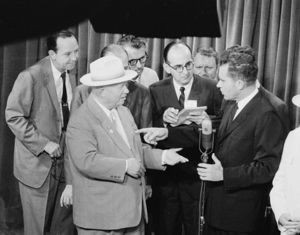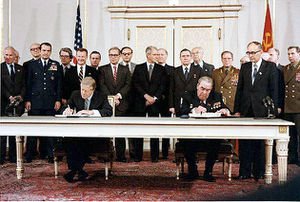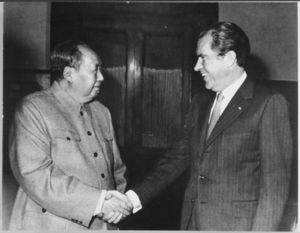Why did the United States and Soviet Union Reach Detente During the Cold War
Detente was a period lasting from 1972 to 1981. There was a thaw in relations between the United States and the Soviet Union during this time frame. Several major and surprising events, including the end of American involvement in the Vietnam War, a significant economic downturn in the West, and the opening of relations with China, occurred contemporaneously with the thaw. This period proved to be starkly different than the escalations in Cold War tensions in the 1960s and 1980s and is generally attributed to Richard Nixon's deft diplomacy.
The Collapse of US/USSR relations after World War 2
The years leading up to the rapprochement between the United States and the Soviet Union were often tense. The 1950s saw a massive military buildup on both sides, with the number of deployable nuclear weapons reaching into the tens of thousands. Furthermore, the 1950s and 1960s saw other countries, including the U.K., France, and China, each joining the nuclear club. The defining moment of this arms race was the 1962 Cuban Missile Crisis that brought the superpowers to the brink of war.
Additionally, the two sides were locked in a series of crises and wars across the globe. The Soviet Union began construction on the infamous Berlin Wall in 1961 to prevent people from leaving East Berlin. There were successive crises over Taiwan and the straits. The largest of these issues was indeed the Vietnam War.
Although the United States had been sending advisers to anti-Communist South Vietnam since France left its former colony in the 1950s, the involvement quickly escalated in the mid-1960s. The U.S. utilized drafted soldiers, causing tremendous resentment on the home front. Furthermore, the South Vietnamese regime was unstable, facing several coups and general unpopularity. By 1968 there were already over 600,000 combat troops in the country, representing the peak of American intervention.
The Seeds of Détente?
By 1969, foreign relations between the United States and the Soviet Union were stressed. Still, there were a series of essential shifts in the United States, China, and the Soviet Union that changed policy. In the Soviet Union, Premier Nikita Khrushchev was replaced by party hardliner Leonid Brezhnev. There was also increasing tension between the U.S.S.R. and the People's Republic of China, which resulted in a brief border conflict in 1969.
China's Great Leap Forward, intended to modernize and industrialize the country, was a tragic human and financial disaster. Dictator Mao Zedong was forced to seek alternatives to Soviet hegemony. The United States saw a prolonged period of instability initiated by the assassination of President John Kennedy in November 1963. Protests against involvement in Vietnam and a series of social issues continued to grow. By 1968 President Lyndon Johnson was broken in spirit and decided not to run for re-election. [1]
It was in this atmosphere that former Vice President Richard Nixon reemerged. Having served under President Eisenhower from 1953-1961, Nixon ran unsuccessfully for the White House against Kennedy in 1960. Nixon also launched a failed bid for California governor in 1964 and declared that his political life was over. Nixon had developed a contentious but respectful role with Soviet leaders, even flying to Moscow for a debate with Khrushchev on the strengths of a capitalist system, dubbed the "Kitchen Debate" in 1959. Nixon's return in 1968 was built on the twin ideas that he would be tough on Communism and crackdown on instability through his 'law and order' platform.
Détente becomes Possible
Nixon's ascension brought competing for ideas to light. In one regard, he was a Cold Warrior, launching a significant escalation of bombing in Vietnam (and later Cambodia and Laos) while also dramatically reducing the number of combat troops in Southeast Asia. Nixon also ended the draft, undercutting a major argument of American doves. As both Brezhnev and Nixon were looked upon as hardliners, it appeared that a thaw might not be possible. The year before Nixon took office, Brezhnev launched bloody repression of an uprising in Czechoslovakia.
The United States also saw the emerging Sino-Soviet split. Mao bitterly resented Khrushchev's de-Stalinization, and the Soviets feared China joining the nuclear club. China was growing increasingly uneasy with the Soviets' role in Vietnam, disliking the idea of a Soviet client state on their southern border. With this backdrop, Nixon began negotiations with Soviet Premier Brezhnev in 1969 on bilateral arms reduction treaties. The first was the Strategic Arms Limitation Treaty, or SALT, which limited the number of nuclear warheads on each side.
The two superpowers agreed to the Anti-Ballistic Missile Treaty, or ABM, which limited the number of anti-ICBM defenses each nation would develop. This thaw grew into a wider policy, known as Detente between East and West. One of the largest and most symbolic acts was the agreement between many capitalist and Communist nations to sign the Helsinki Accords in 1975 to improve relations further. A follow-up SALT II Treaty was signed by Brezhnev and Carter in 1979. [2]
Opening Relations with China
The emergence of China on the geopolitical scene almost created a tri-polar world. China by the end of the 1960s did not fall in the Soviet camp, and Mao believed that the U.S.S.R. was adulterating Communist ideology. The U.S. has refused to recognize the People's Republic since its victory in the Chinese Civil War in 1949. Chinese involvement against United Nations forces in the Korean War also deepened mistrust. However, this changed by the early 1970s. The two countries exchanged friendly ping-pong athletes for exhibition games, which evolved into deeper and deeper talks. Nixon had fostered such talks since his first term began in 1969, but by 1971 National Security Adviser Henry Kissinger traveled secretly to Beijing to begin talks of a deeper thaw. [3]
In July 1971, Nixon shocked audiences in both the United States and the Soviet Union by announcing visiting China. In February 1972, he made the journey and had a cordial meeting with Mao. The United States also recognized China, allowing the PRC to take Taiwan's seat at the United Nations. Shortly after that, full diplomatic and commercial ties were established. Presidents Nixon, Ford, and Carter attempted to use this as leverage to smooth relations further. Under improved relations and further local diplomacy, the United States removed combat troops from Vietnam in 1973.
Conclusion
The better relations between the United States with China and the Soviet Union were not a permanent development. As the United States and its allies fell into a deep "malaise" in the late 1970s, the Soviets attempted to take advantage of the situation. The Soviets expanded their influence in the Middle East and invaded Afghanistan to prop up a puppet government in 1979. Brezhnev also kept Eastern Europe repressed with a heavy hand through the remainder of his dictatorship. Against this backdrop, former California Governor Ronald Reagan ran and won for President in 1980, promising to end the Detente.
References
Updated October 7, 2021.



